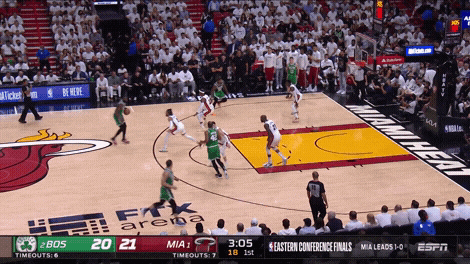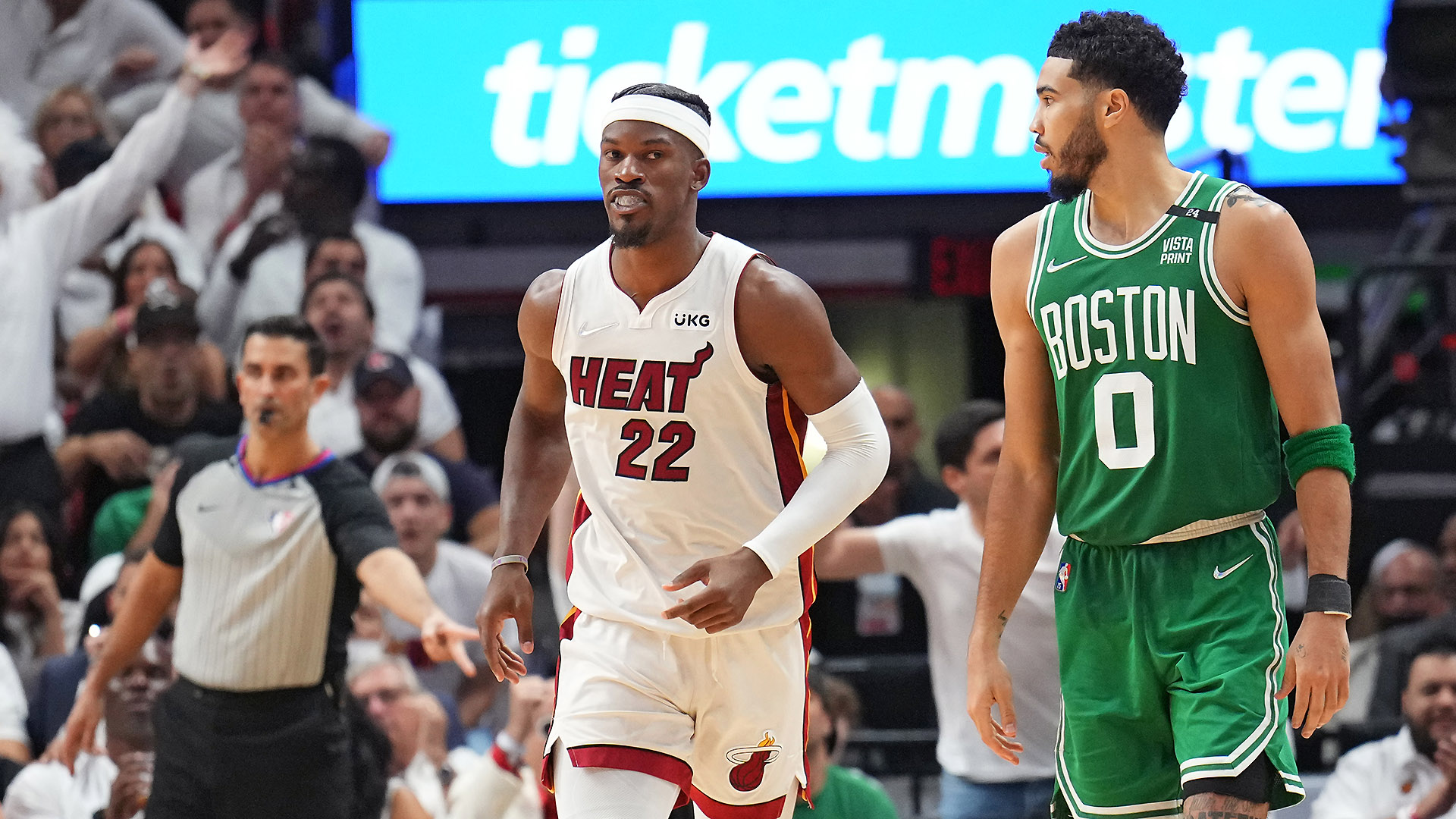Jayson Tatum sets the tone on offense and Marcus Smart returns as Boston takes Game 2 vs. Miami.
• Heat vs. Celtics: Complete series coverage
MIAMI — The Boston Celtics had an answer in Game 2 of the Eastern Conference finals.
Actually, they had a lot of answers. And they blew out the Miami Heat on Thursday, evening the series at 1-1. Miami actually led by 10 early, but Boston then went on a remarkable 60-21 run spanning the first and second quarters. That put the Celtics up 29 with a little more than a minute left in the half.
Here are some notes, numbers and film from the Celtics’ 127-102 victory, with the series now moving to Boston for Games 3 and 4.
1. The most efficient half
After they trailed 18-8, the Celtics scored 56 points on their next 31 possessions. That’s a rate of 1.81 per possession, which is like shooting better than 90%, basically getting layups and dunks on 31 straight trips down the floor. Really, they were just 5-for-6 in the restricted area over that stretch, but they were 4-for-7 on other 2-point shots, 8-for-8 from the free-throw line, and 10-for-15 from 3-point range.
Jaylen Brown ran the offense for the second part of the first quarter, and the Celtics had success when they put Dewayne Dedmon into the pick-and-roll. Dedmon blitzed those pick-and-rolls and Boston feasted.
First, Brown split the defenders, blowing by Dedmon, drawing help from the weak side, and kicking out to Payton Pritchard for a wide open 3 …

Then Dedmon and Jimmy Butler trapped Brown along the sideline. Brown quickly got off the ball and Marcus Smart got an in-rhythm 3 two passes later …

Two possessions later, Dedmon blitzed and trapped again. This time, Grant Williams got an open 3 when Victor Oladipo didn’t commit to the rotation …

That’s good offense. But the floodgates really opened when the Celtics hit some tougher shots. Their ninth 3-pointer (on just 11 attempts) of the first quarter was a deep one from Brown with Oladipo giving a decent contest …

“The shot making,” Heat coach Erik Spoelstra said, “That got us out of what we normally do, and that’s what shot making can do. If you start the game 9-of-11 from three, that will get you out of your habits pretty quickly.”
In total, the Celtics’ first half — 70 points on 44 possessions (1.59 per) — was their third most efficient half this season and the most efficient half for any team in these playoffs. And it came against the defense that ranked fourth in the regular season and second in the playoffs prior to Thursday.
2. The shortest rotation
After missing Game 1, both Smart (foot sprain) and Al Horford (Health and Safety Protocols) were back for the Celtics. That doesn’t mean that coach Ime Udoka extended his rotation. Derrick White missed the game for personal reasons and (save for one defensive possession for Aaron Nesmith at the end of the third quarter) Udoka played only seven guys for the first 42 minutes of Game 2.
Marcus Smart returns, helps Celtics steal home-court advantage.
Smart was the guy who was returning from an injury (a foot sprain) and he played 40:18, seven more minutes than anybody else on either team. And that was with the Celtics leading by no fewer than 17 points for the last 30:54 of this game. Smart finished with 24 points, nine rebounds, 12 assists (with just one turnover) and three steals. He had a fantastic game and didn’t look injured at all. Maybe he was hunting a triple-double.
But this series doesn’t have any two-day breaks. These teams will play every other day until one of them has won four games, so heavy minutes in a blowout could be a factor down the road.
3. Heat go down another man
Miami was without Kyle Lowry, who has now missed four straight games (and eight of the last 10) with a hamstring injury. And on Thursday, they lost another starter, with P.J. Tucker leaving midway through the third quarter with a left knee contusion.
The Heat’s starting lineup, with Gabe Vincent in Lowry’s place, has outscored its opponents by 22.3 points per 100 possessions, the best mark among the 10 lineups that have played at least 75 minutes in the playoffs. But with Boston’s huge run coming mostly with Miami reserves on the floor, the Heat’s bench now ranks 14th (in regard to aggregate point differential per 100 possessions) in the playoffs.
P.J Tucker left Game 2 vs. Boston because of a left knee injury.
If Tucker is unable to play on Saturday, that bench gets thinner and the Heat are without the guy who’s been primarily defending Jayson Tatum.
“I don’t have an update right now,” Spoelstra said in regard to Tucker’s injury. “If you ask him, he says he’s good to go. We’ll just have to see tomorrow. I’ll talk to the trainers.”
4. Picking on the wrong guy?
The Heat’s issues in that first half were mostly on the defensive end of the floor. But as the Celtics were turning a six-point deficit into an 11-point lead late in the first quarter, the Heat scored on just one of their final eight possessions of the period.
And it seems they were picking on the wrong guy. In the fourth quarter of Game 1, the Heat had success by putting Pritchard in pick-and-roll actions. And the 6-foot-1 Pritchard was on the floor for the final 4:14 of the first quarter of Game 2. But the Heat kept putting Horford into pick-and-rolls instead.
They initially had some success. Tucker set a screen for Tyler Herro, Horford played soft, and Herro drained an and-1 pull-up jumper with Brown fouling him from behind.
But on the next possession, Horford switched the screen and Herro and turned the ball over …

On the next possession, Horford was guarding Oladipo. So the Heat had him set a screen for Vincent. Horford switched again, stayed in front of Vincent’s drive, and forced a tough, contested turnaround jumper …

Two possessions later, Oladipo got a pretty good look at a pull-up 3 when Horford sat back on a handoff from Butler (Horford’s second switch of the possession). And on the following possession, the Heat actually targeted Pritchard, but Butler missed a jumper.
But they went after Horford again on two of their final three possessions of the period, with Herro missing a pull-up 3 over the Celtics’ big man and Horford staying in front of a Butler iso drive …

According to Synergy play-type tracking, Horford has defended 52 isolations in the playoffs, 17 more than any other player. And the 0.60 points per possession he’s allowed on those is the best mark among 17 players who’ve defended at least 20 iso possessions.
“He’s still moving like he’s 22,” Smart said of the 35-year-old Horford. “That’s been an advantage for us. He’s an athletic long guy who can get out and switch on to those smaller, quicker guards, and it really keeps our defense compact. It’s not really a mismatch that teams can really try to go after.”
5. Miami’s turn to respond
A 25-point defeat counts for just one loss. The Heat (2-3 on the road in the playoffs) have lost home-court advantage, but they’ve got two chances to get it back before they return to Miami for Game 5.
“I don’t like to move on from this because it has to hurt,” Butler said. “They tried to embarrass us. They did embarrass us. So I think we got to realize that, use it as fuel, whatever you want to say, but realize the game can get out of hand when you’re playing against a really good team like them that can score the ball and get stops.
“Overall, we have to be better. We have a tough job to do to go over there and win, but if they did it, we can do it, as well.”
These two teams lead the league in the most games led by 20 points or more. The Celtics are now 33-1 (with 24 straight wins) after leading by at least 20, while the Heat (who led Game 1 by as many as 20) are 33-0. Maybe we’ll get a close game Game 3 on Saturday in Boston (8:30 ET, ABC).
* * *
John Schuhmann is a senior stats analyst for NBA.com. You can e-mail him here, find his archive here and follow him on Twitter.
The views on this page do not necessarily reflect the views of the NBA, its clubs or Turner Broadcasting.










